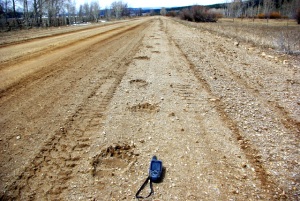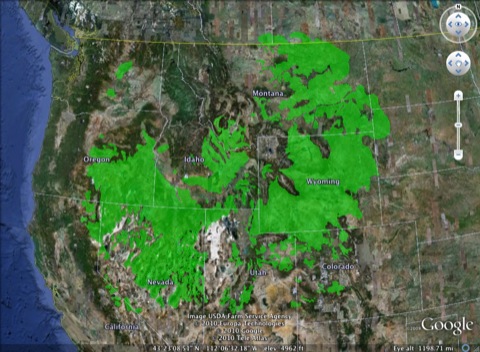State will not manage wolves nor control poaching-
Idaho won’t manage wolves under ESA – John Miller, AP
“After talks with the federal government collapsed, Gov. C.L. ‘Butch’ Otter ordered Idaho wildlife managers Monday to relinquish their duty to arrest poachers or to even investigate when wolves are killed illegally.”
From his first day in office, Butch Otter has made wolves his signature issue even as the state of Idaho has drifted and floundered. Otter single-handedly destroyed the grudging acceptance wolf conservation groups were granting the Idaho and Montana wolf management plans. His threats to kill the first wolf in an Idaho wolf hunt, and bring their numbers down to the bare minimum . . . maybe kill them all . . . are real root of the current antagonism and anger that permeates the region.
When people point fingers about conservationists bringing lawsuits, they don’t need to look much beyond Butch Otter, who made it clear from start he would not listen to them, didn’t care, and wanted trouble.
Now it is up to the federal government to cave to Otter, manage the wolves, or redesignate someone like the Nez Perce Tribe to manage wolves in Idaho. The Tribe did an excellent job, and most of Idaho and Montana’s original wolf mangers were trained with the Tribe and moved into state roles when the states took over. The Tribe is not jumping at the chance to take up wolf management again. Rocky Barker: Nez Perce Tribe prefers to dodge Idaho wolf job. Idaho Statesman.
Because Idaho is no longer going to arrest poachers and it is currently the hunting season, a slaughter of wolves might be in order unless the federal government quickly brings in law enforcement. Because Idaho is no longer managing wolves, Wildlife Services, which is a federal agency though they rarely act like it, should no longer be killing wolves.
We have to wonder if Idaho Fish and Game will now let the radio frequencies of wolves fall into the hands of the poachers.
We think that gubernatorial politics also figures in this. Otter is facing a stiff Challenger from Keith Allred, a Democrat who is getting support from many Republicans who sense an extremism as well as lack of an economic plan in Otter’s administration. We note the Otter had to bring in Mitt Romney to campaign for him, most likely because Otter is weak with the LDS (Mormon) voters of Eastern Idaho. We don’t seem to see much more than a pro forma Otter campaign in Eastern Idaho. Otter’s opponent Keith Allred, is not a wolf supporter, but is not campaigning as a hothead.
This is a classic political stunt for a politician with a poor record fighting a tough campaign — pick a fight, especially one with a lot of emotion, but one which won’t cost the state money.
– – – – –
Otter’s News Release
(BOISE) – Governor C.L. “Butch” Otter notified Interior Secretary Ken Salazar today that Idaho no longer will act as the federal government’s “designated agent,” managing wolves imposed on the state under the Endangered Species Act.
Instead, the Governor directed the Idaho Fish and Game Commission to immediately refocus its efforts on protecting Idaho’s deer, elk and moose, and said the Idaho Department of Fish and Game will be submitting applications to the Interior Department for additional flexibility in addressing wolf depredation issues “so we can exercise our sovereign right to protect our wildlife.”
“This directive preserves an individual’s right to kill a wolf in self defense or in the defense of another person. It does not jeopardize the existing flexibility landowners and permittees have to protect their livestock and pets from wolves,” Governor Otter wrote in a letter to Salazar. “Additionally, this approach does not ask Idahoans who continue suffering wolves – especially sportsmen – to subsidize any part of this federal program or bear the risk or burden of inadequate federal funding in the future.”
In his letter, the Governor reiterated that the State of Idaho has consistently proven itself to be a responsible steward of all wildlife – “including your wolves.”
“We also showed that we could successfully manage a hunting season for wolves as we do for other species,” he said. “The State managed wolves as part of the ecosystem, in concert with other species and needs, which was ironically decried by environmentalists who seemingly want wolves to benefit at the expense of other wild and domestic species.”
“I am still committed to finding a path forward for delisting. My goal remains restoring State management under our approved plan as quickly as possible, if for no other reason than to fulfill the promise of our State law that all wildlife within our borders will be managed by the State. To that end, I am encouraged by the efforts of representatives from the three legislatures (Idaho, Montana and Wyoming) to see if there is a path forward for delisting and state management,” Governor Otter wrote to Salazar. “Although we could not agree during the course of our negotiations, I share your commitment to delist the species and restore state management as quickly as possible. It is truly frustrating that we cannot accomplish that shared goal today.”





























